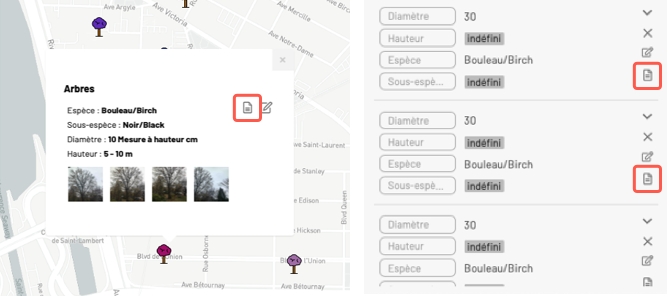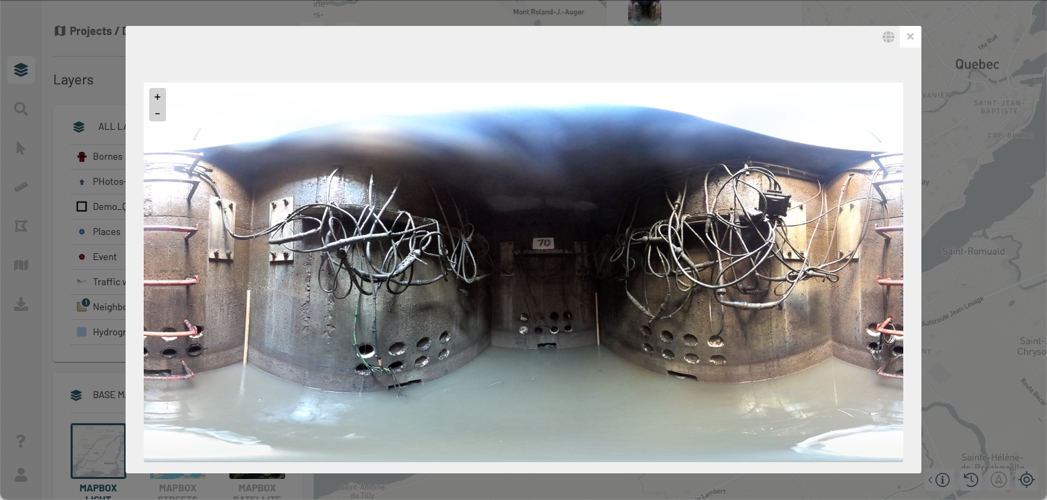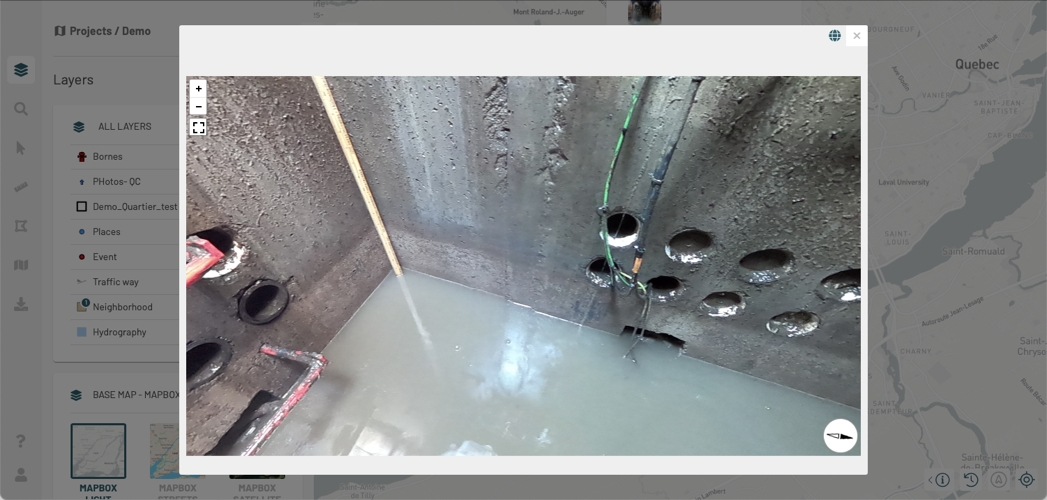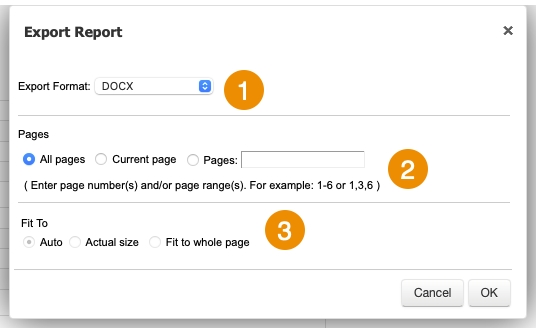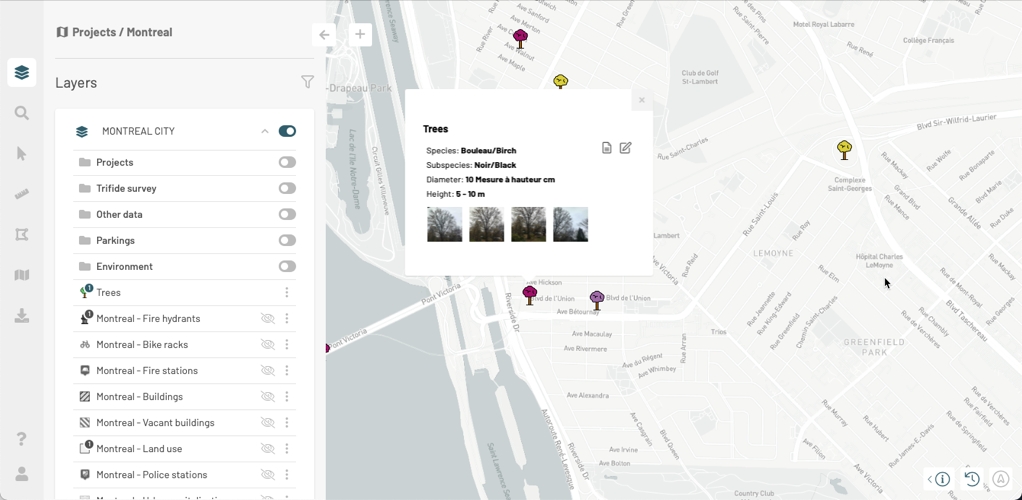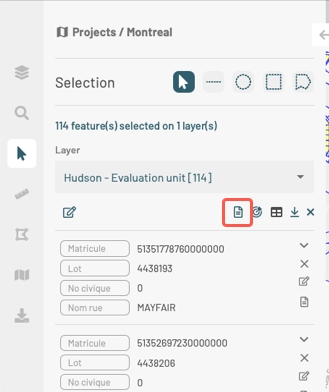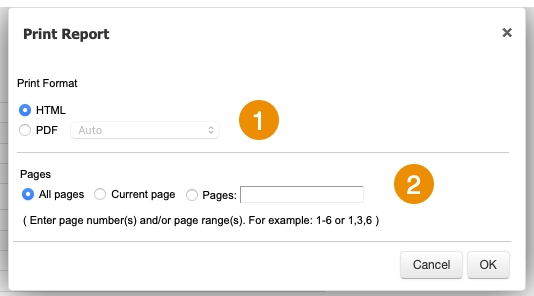Several tools are available in JMap NG to display information about map elements.
Some map elements will display a tooltip when you touch them or when you click on them. The tooltip contains information on the element's attributes, and it can include text, hyperlinks to open documents or videos in their native applications, photos, etc.
Tooltips also provide access to tools for editing items (if the layer is editable and you have the editing permissions) and to information reports (if the layer has reports configured).
Tooltips are displayed temporarily for one element at a time.
To display a tooltip:
Click on an element whose tooltip you wish to display. The tooltip automatically appears.
Click on a photo to enlarge it and to display its title and comments. If the photo is a 360-degree photo, the viewer opens automatically in panoramic mode.
Use the and buttons to navigate the photo or to view it in full screen.
Click on to see the photo in standard mode.
Click on to see the photo in panoramic mode.
Click on to close the 360-degree photo viewer.
Click on to download the photo.
Click on another photo to enlarge it.
In the tooltip, click on to modify the element. The Editing Data section contains the details of this topic.
In the tooltip, click on to open the feature information report. This icon only appears in the tooltip of layers that have reports of information configured. The Information Reports section provides details on the subject.
Click on to close the tooltip or click on another map object to open its tooltip.
Information reports present information from the layer or from other data sources that relate to layer elements.
They can be very simple (a PDF document) or they can contain maps, graphics and photos, information which can be static or dynamic, i.e. which can be updated in near real time, depending on report configuration. Tools may also be available to export information to other formats. The JMap administrator can configure several reports for the same layer.
You can view the information report of a single map element or a set of elements issue from a search based on the values attributes of the elements or from the interactive selection on the map.
The icon in a tooltip or in the card of a map element selected from an interactive selection or search, indicates that the layer has at least one report of information.
1
Name of the map layer.
2
Name of the report.
3
The element’s descriptive data.
4
Tools allowing you to:
1
Name of the map layer to which the selected elements belong.
2
Name of the report.
3
Elements are displayed in rows, and the columns represent the element attributes.
4
Tools allowing you to:
Data contained in the report can be exported to a CSV file to be processed with other software.
1
Name of the database containing the data.
2
3
4
CSV is the file format.
5
You can select a type of encoding for the data.
6
You must specify a separator for the data columns.
7
You can specify a column format. This information is important to read the data with databases or other software (when the CSV file is open in Excel, for instance).
The report can be exported to a file.
1
Format of the file to which the report will be exported. The following formats are available: DOCX, Excel (XLS), OpenDocument Presentation (ODP), OpenDocument Spreadsheet (ODS), OpenDocument Text (ODT), PDF, PostScript (PS), PowerPoint (PPT), PPTX, Spudsoft Excel, Word (DOC), XLSX.
2
You can select the report pages you wish to export.
3
You can configure how the report will fit in the file.
The report can be saved in a certain format for printing and sharing purposes.
1
The format in which the report will be printed. The following formats are available: HTML and PDF. PDF offers three options: - Auto: Adjusts the document automatically. - Actual size: Maintains the current size of the report. - Fit to whole page: Adjusts the size of the report to a single page.
2
You can select the report pages you wish to print.
Click on to open the report in a new tab in the browser window.
to a file.
to a file.
.
The icon indicates that the layer has at least one report of information.
Click on to open the report in a new tab in the browser window.
to a file.
to a file.
.
Attributes that contain descriptive data for the element and that are available to be exported. Using the and arrows, you can select the attributes you wish to export.
Attributes that are exported to the file. Using the and arrows, you can remove attributes from the selection. Using the and arrows, you can modify the order of the attributes in the file.


